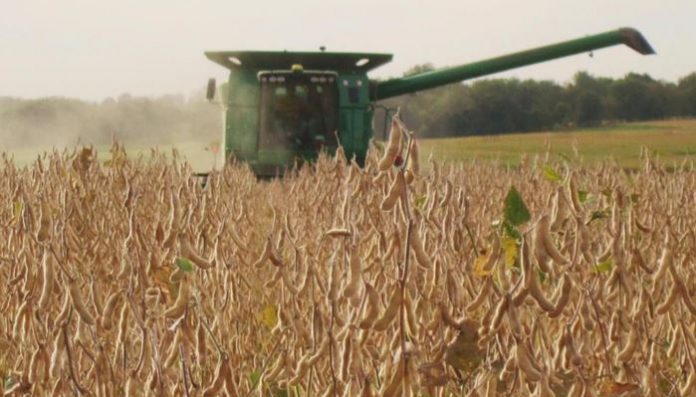
EVANSVILLE, Ind., Sept. 24 (UPI) — The United States is expecting its largest-ever soybean harvest this fall, and due to the trade war with China, economists predict that much of that harvest will not be sold.
A record-breaking harvest would normally be good news for farmers. But this summer, the U.S. lost its No. 1 soybean importer. China, which bought nearly 30 percent of America’s soybeans last year, placed a high tariff on the commodity in July in response to similar tariffs levied by the Trump administration, forcing Chinese buyers to look elsewhere.
Without the Chinese market, hundred of thousands of bushels of American soybeans harvested this fall will have nowhere to go.
“The inventory that farmers can’t sell is going to have to stay in storage,” said Chris Hurt, a professor of agricultural economics at Purdue University. “We’re going to have a record amount of soybeans in storage this year.”
This year’s record-breaking harvest was caused partly by good weather, Hurt said. And partly because farmers purposefully planted more soy.
In the spring, when farmers were deciding what to plant, the price for soy was expected to reach an all-time high — largely because of the growing demand for soybeans in China.
“So in the springtime when they were planting, farmers favored soy,” Hurt said.
Recognizing the hardship farmers are facing because of the tariffs, the Trump administration announced it will provide farmers with relief money for this year’s harvest. Soy growers will get $1.65 per bushel on 50 percent of their total harvest. By some estimates, that will cover nearly half of farmer’s expected tariff losses, said Chad Hart, an economist at Iowa State University.
Farmers are hopeful that aid will tide them over until the demand for American soy returns and they are able to sell their beans.
“I’m 20 percent above my average soybean yield right now,” Mark Jackson, an Iowa farmer, told UPI from his combine tractor, as he harvested this year’s crop. “What I’m doing, and what most farmers are doing, is putting their beans in grain bins and waiting to see if the prices increase.”
Jackson, like many farmers, has the capacity to store some of his unsold beans on his farm, he said. The rest will have to be shipped to grain elevators — companies that stockpile and store grain.
Economists predict much of the beans will remain in storage until the trade war between the U.S. and China ends, and the soy tariffs are removed.
There is no sign of that happening anytime soon.
China called off planned trade talks with U.S. officials as the latest round of retaliatory tariffs went into effect Monday. This is the third round of tariffs on Chinese goods entering the United States. It places 10 percent tariffs on $200 billion of Chinese products, including furniture and appliances. The rate will increase to 25 percent by the end of the year.
The trade conflict began earlier this year when the United States placed a 30 percent tariff on $50 billion of Chinese imports in retaliation for what President Donald Trump called China’s practice of stealing intellectual property from American companies. Instead of altering its policies, China hit back with tariffs of its own, many of which targeted American agricultural exports.
“It’s a high-risk strategy,” Hurt said. “The difficulty with trade wars is once they start it’s difficult to say, ‘Let’s stop now.’ What happens is you slap them, then they slap you back. So you punch them, and they punch you back. So you take out a gun and shoot them in the foot. This escalation happens in military wars, personal conflicts and in trade wars. It’s hard to predict how long it will last. Obviously, farmers are hoping it won’t last long.”





